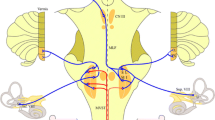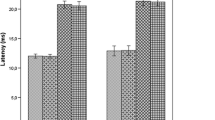Abstract
Vestibular-evoked myogenic potentials (VEMP), short-latency electromyographic responses elicited by acoustic stimuli, evaluate the function of vestibulocollic reflex and may give information about brainstem function. The aim of the present study is to evaluate the potential contribution of VEMP to the diagnosis of multiple sclerosis (MS). Fifty patients with MS and 30 healthy control subjects were included in this study. The frequency of VEMP p1–n1 and n2–p2 waves; mean p1, n1, n2, and p2 latency; and mean p1–n1 and n2–p2 amplitude were determined. The relation between clinical and imaging findings and VEMP parameters was evaluated. The p1–n1 and n2–p2 waves were more frequently absent in MS than in control subjects [p1–n1 wave absent: MS, 25 (25 %) ears; control, 6 (10 %) ears; P ≤ 0.02] [n2–p2 wave absent: MS, 44 (44 %) ears; control, 7 (12 %) ears; P ≤ 0.001]. The mean p1–n1 amplitude was lower in MS than in control subjects (MS, 19.1 ± 7.2 μV; control, 23.3 ± 7.4 μV; P ≤ 0.002). A total of 24/50 (48 %) MS patients had VEMP abnormalities (absent responses and/or prolonged latencies). VEMP abnormalities were more frequent in patients with than without vestibular symptoms (P ≤ 0.02) and with brainstem functional system score (FSS) ≥1 than FSS = 0 (P ≤ 0.02). In patients with MS, absence of p1–n1 wave was more frequent in patients with than without vestibular symptoms [absence of p1–n1 wave: vestibular symptoms, 9 (45 %) ears; no vestibular symptoms, 16 (20 %) ears; P ≤ 0.03] and patients with Expanded Disability Status Scale (EDSS) score ≥5.5 [absence of p1–n1 wave: EDSS ≥5.5, 7 (70 %) ears; EDSS <5.5, 18 (20 %) ears; P ≤ 0.001]. Abnormal VEMP may be noted in MS patients, especially those with vestibular symptoms and greater disability. The VEMP test may complement other studies for diagnosis and follow-up of patients with MS.
Similar content being viewed by others
References
Colebatch JG, Halmagyi GM, Skuse NF (1994) Myogenic potentials generated by a click-evoked vestibulocollic reflex. J Neurol Neurosurg Psychiatry 57:190–197
McCue MP, Guinan JJ Jr (1997) Sound-evoked activity in primary afferent neurons of a mammalian vestibular system. Am J Otol 18:355–360
Kushiro K, Zakir M, Ogawa Y, Sato H, Uchino Y (1999) Saccular and utricular inputs to sternocleidomastoid motoneurons of decerebrate cats. Exp Brain Res 126:410–416
Rosengren SM, Welgampola MS, Colebatch JG (2010) Vestibular evoked myogenic potentials: past, present and future. Clin Neurophysiol 121:636–651
Patko T, Vidal PP, Vibert N, Tran Ba Huy P, de Waele C (2003) Vestibular evoked myogenic potentials in patients suffering from a unilateral acoustic neuroma: a study of 170 patients. Clin Neurophysiol 114:1344–1350
Ochi K, Ohashi T, Watanabe S (2003) Vestibular-evoked myogenic potential in patients with unilateral vestibular neuritis: abnormal VEMP and its recovery. J Laryngol Otol 117:104–108
Murofushi T, Matsuzaki M, Mizuno M (1998) Vestibular evoked myogenic potentials in patients with acoustic neuromas. Arch Otolaryngol Head Neck Surg 124:509–512
de Waele C, Huy PT, Diard JP, Freyss G, Vidal PP (1999) Saccular dysfunction in Meniere’s disease. Am J Otol 20:223–232
Itoh A, Kim YS, Yoshioka K, Kanaya M, Enomoto H, Hiraiwa F, Mizuno M (2001) Clinical study of vestibular-evoked myogenic potentials and auditory brainstem responses in patients with brainstem lesions. Acta Otolaryngol Suppl 545:116–119
Chen CH, Young YH (2003) Vestibular evoked myogenic potentials in brainstem stroke. Laryngoscope 113:990–993
Bayir O, Comoglu SS, Ozdek A, Aytaç E, Guven H, Ozdal MP, Korkmaz H (2012) Vestibular evoked myogenic potential responses in Behçet’s disease. Int Adv Otol 8:113–117
Patkó T, Simó M, Arányi Z (2007) Vestibular click-evoked myogenic potentials: sensitivity and factors determining abnormality in patients with multiple sclerosis. Mult Scler 13:193–198
Sartucci F, Logi F (2002) Vestibular-evoked myogenic potentials: a method to assess vestibulo-spinal conduction in multiple sclerosis patients. Brain Res Bull 59:59–63
Versino M, Colnaghi S, Callieco R, Bergamaschi R, Romani A, Cosi V (2002) Vestibular evoked myogenic potentials in multiple sclerosis patients. Clin Neurophysiol 113:1464–1469
Alpini D, Pugnetti L, Caputo D, Cornelio F, Capobianco S, Cesarani A (2004) Vestibular evoked myogenic potentials in multiple sclerosis: clinical and imaging correlations. Mult Scler 10:316–321
Bandini F, Beronio A, Ghiglione E, Solaro C, Parodi RC, Mazzella L (2004) The diagnostic value of vestibular evoked myogenic potentials in multiple sclerosis. J Neurol 251:617–621
Eleftheriadou A, Deftereos SN, Zarikas V, Panagopoulos G, Sfetsos S, Karageorgiou CL, Ferekidou E, Kandiloros D, Korres S (2009) The diagnostic value of earlier and later components of Vestibular Evoked Myogenic Potentials (VEMP) in multiple sclerosis. J Vestib Res 19:59–66
Gazioglu S, Boz C (2012) Ocular and cervical vestibular evoked myogenic potentials in multiple sclerosis patients. Clin Neurophysiol 123:1872–1879
Birdane L, Incesulu A, Gurbuz MK, Özbabalik D (2012) Sacculocolic reflex in patients with dementia: is it possible to use it for early diagnosis? Neurol Sci 33:17–21
Comi G, Leocani L, Medaglini S, Locatelli T, Martinelli V, Santuccio G, Rossi P (1999) Measuring evoked responses in multiple sclerosis. Mult Scler 5:263–267
Shimizu K, Murofushi T, Sakurai M, Halmagyi M (2000) Vestibular evoked myogenic potentials in multiple sclerosis. J Neurol Neurosurg Psychiatry 69:276–277
Murofushi T, Shimizu K, Takegoshi H, Cheng PW (2001) Diagnostic value of prolonged latencies in the vestibular evoked myogenic potential. Arch Otolaryngol Head Neck Surg 127:1069–1072
Wu CC, Young YH (2002) Vestibular evoked myogenic potentials are intact after sudden deafness. Ear Hear 23:235–238
Robertson DD, Ireland DJ (1995) Vestibular evoked myogenic potentials. J Otolaryngol 24:3–8
Huang TW, Young YH, Cheng PW (2004) Eliciting constant and prominent waves n34–p44 of vestibular-evoked myogenic potentials. Acta Otolaryngol 124:1022–1027
Conflict of interest
None.
Author information
Authors and Affiliations
Corresponding author
Rights and permissions
About this article
Cite this article
Güven, H., Bayır, Ö., Aytaç, E. et al. Vestibular-evoked myogenic potentials, clinical evaluation, and imaging findings in multiple sclerosis. Neurol Sci 35, 221–226 (2014). https://doi.org/10.1007/s10072-013-1483-9
Received:
Accepted:
Published:
Issue Date:
DOI: https://doi.org/10.1007/s10072-013-1483-9




